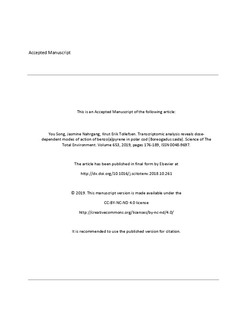| dc.contributor.author | Song, You | |
| dc.contributor.author | Nahrgang, Jasmine | |
| dc.contributor.author | Tollefsen, Knut Erik | |
| dc.date.accessioned | 2019-11-18T12:40:10Z | |
| dc.date.available | 2019-11-18T12:40:10Z | |
| dc.date.created | 2018-11-06T15:18:16Z | |
| dc.date.issued | 2019 | |
| dc.identifier.citation | Science of the Total Environment. 2019, 653 176-189. | |
| dc.identifier.issn | 0048-9697 | |
| dc.identifier.uri | http://hdl.handle.net/11250/2629051 | |
| dc.description.abstract | Polar cod (Boreogadus saida) has been used as a model Arctic species for hazard assessment of environmental stressors such as polycyclic aromatic hydrocarbons (PAHs). However, most of the PAH studies using polar cod rely on targeted biomarker-based analysis thus may not adequately address the complexity of the toxic mechanisms of the stressors. The present study was performed to develop a broad-content transcriptomic platform for polar cod and apply it for understanding the toxic mechanisms of a model PAH, benzo(a)pyrene (BaP). Hepatic transcriptional analysis using a combination of high-density polar cod oligonucleotide microarray and quantitative real-time RT-PCR was conducted to characterize the stress responses in polar cod after 14d repeated dietary exposure to 0.4 (Low) and 20.3 μg/g fish/feeding (High) BaP doses. Bile metabolic analysis was performed to identify the storage of a key BaP hepatic biotransformation product, 3-hydroxybenzo(a)pyrene (3-OH-BaP). The results clearly showed that 3-OH-BaP was detected in the bile of polar cod after both Low and High BaP exposure. Dose-dependent hepatic stress responses were identified, with Low BaP suppressing genes involved in the defense mechanisms and High BaP inducing genes associated with these pathways. The results suggested that activation of the aryl hydrocarbon receptor signaling, induction of oxidative stress, DNA damage and apoptosis were the common modes of action (MoA) of BaP between polar cod or other vertebrates, whereas induction of protein degradation and disturbance of mitochondrial functions were proposed as novel MoAs. Furthermore, conceptual toxicity pathways were proposed for BaP-mediated effects in Arctic fish. The present study has for the first time reported a transcriptome-wide analysis using a polar cod-specific microarray and suggested novel MoAs of BaP. The analytical tools, bioinformatics solutions and mechanistic knowledge generated by this study may facilitate mechanistically-based hazard assessment of environmental stressors in the Arctic using this important fish as a model species. | |
| dc.language.iso | eng | |
| dc.title | Transcriptomic analysis reveals dose-dependent modes of action of benzo(a)pyrene in polar cod (Boreogadus saida) | |
| dc.title.alternative | Transcriptomic analysis reveals dose-dependent modes of action of benzo(a)pyrene in polar cod (Boreogadus saida) | |
| dc.type | Peer reviewed | |
| dc.type | Journal article | |
| dc.description.version | acceptedVersion | |
| dc.source.pagenumber | 176-189 | |
| dc.source.volume | 653 | |
| dc.source.journal | Science of the Total Environment | |
| dc.identifier.doi | 10.1016/j.scitotenv.2018.10.261 | |
| dc.identifier.cristin | 1627646 | |
| dc.relation.project | Norges forskningsråd: 214184 | |
| dc.relation.project | Norges forskningsråd: 195160 | |
| dc.relation.project | Norsk institutt for vannforskning: SIS programme for Compounds of Emerging Concern (MolPoP) | |
| cristin.unitcode | 192,14,0,0 | |
| cristin.unitname | Miljøvitenskap og naturforvaltning | |
| cristin.ispublished | true | |
| cristin.fulltext | postprint | |
| cristin.qualitycode | 2 | |
